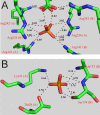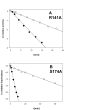Orthophosphate binding at the dimer interface of Corynebacterium callunae starch phosphorylase: mutational analysis of its role for activity and stability of the enzyme
- PMID: 20113461
- PMCID: PMC2837607
- DOI: 10.1186/1471-2091-11-8
Orthophosphate binding at the dimer interface of Corynebacterium callunae starch phosphorylase: mutational analysis of its role for activity and stability of the enzyme
Abstract
Background: Orthophosphate recognition at allosteric binding sites is a key feature for the regulation of enzyme activity in mammalian glycogen phosphorylases. Protein residues co-ordinating orthophosphate in three binding sites distributed across the dimer interface of a non-regulated bacterial starch phosphorylase (from Corynebacterium callunae) were individually replaced by Ala to interrogate their unknown function for activity and stability of this enzyme.
Results: While the mutations affected neither content of pyridoxal 5'-phosphate cofactor nor specific activity in phosphorylase preparations as isolated, they disrupted (Thr28-->Ala, Arg141-->Ala) or decreased (Lys31-->Ala, Ser174-->Ala) the unusually strong protective effect of orthophosphate (10 or 100 mM) against inactivation at 45 degrees C and subunit dissociation enforced by imidazole, as compared to wild-type enzyme. Loss of stability in the mutated phosphorylases appeared to be largely due to weakened affinity for orthophosphate binding. Binding of sulphate mimicking the crystallographically observed "non-covalent phosphorylation" of the phosphorylase at the dimer interface did not have an allosteric effect on the enzyme activity.
Conclusions: The phosphate sites at the subunit-subunit interface of C. callunae starch phosphorylase appear to be cooperatively functional in conferring extra kinetic stability to the native dimer structure of the active enzyme. The molecular strategy exploited for quaternary structure stabilization is to our knowledge novel among dimeric proteins. It can be distinguished clearly from the co-solute effect of orthophosphate on protein thermostability resulting from (relatively weak) interactions of the ligand with protein surface residues.
Figures




Similar articles
-
Tracking interactions that stabilize the dimer structure of starch phosphorylase from Corynebacterium callunae. Roles of Arg234 and Arg242 revealed by sequence analysis and site-directed mutagenesis.Eur J Biochem. 2003 May;270(10):2126-36. doi: 10.1046/j.1432-1033.2003.03562.x. Eur J Biochem. 2003. PMID: 12752432
-
Relationships between structure, function and stability for pyridoxal 5'-phosphate-dependent starch phosphorylase from Corynebacterium callunae as revealed by reversible cofactor dissociation studies.Eur J Biochem. 2004 Aug;271(16):3319-29. doi: 10.1111/j.1432-1033.2004.04265.x. Eur J Biochem. 2004. PMID: 15291809
-
Mutagenesis of the dimer interface region of Corynebacterium callunae starch phosphorylase perturbs the phosphate-dependent conformational relay that enhances oligomeric stability of the enzyme.J Biochem. 2003 Oct;134(4):599-606. doi: 10.1093/jb/mvg178. J Biochem. 2003. PMID: 14607988
-
Starch phosphorylase: role in starch metabolism and biotechnological applications.Crit Rev Biotechnol. 2009;29(3):214-24. doi: 10.1080/07388550902926063. Crit Rev Biotechnol. 2009. PMID: 19708823 Review.
-
Molecular Functions and Pathways of Plastidial Starch Phosphorylase (PHO1) in Starch Metabolism: Current and Future Perspectives.Int J Mol Sci. 2021 Sep 28;22(19):10450. doi: 10.3390/ijms221910450. Int J Mol Sci. 2021. PMID: 34638789 Free PMC article. Review.
Cited by
-
The α-glucan phosphorylase MalP of Corynebacterium glutamicum is subject to transcriptional regulation and competitive inhibition by ADP-glucose.J Bacteriol. 2015 Apr;197(8):1394-407. doi: 10.1128/JB.02395-14. Epub 2015 Feb 9. J Bacteriol. 2015. PMID: 25666133 Free PMC article.
-
Categorisation of culturable bioaerosols in a fruit juice manufacturing facility.PLoS One. 2021 Apr 21;16(4):e0242969. doi: 10.1371/journal.pone.0242969. eCollection 2021. PLoS One. 2021. PMID: 33882058 Free PMC article.
-
Allosteric Regulation of Glycogen Phosphorylase by Order/Disorder Transition of the 250' and 280s Loops.Biochemistry. 2023 Apr 18;62(8):1360-1368. doi: 10.1021/acs.biochem.2c00671. Epub 2023 Mar 29. Biochemistry. 2023. PMID: 36989206 Free PMC article.
References
Publication types
MeSH terms
Substances
LinkOut - more resources
Full Text Sources

